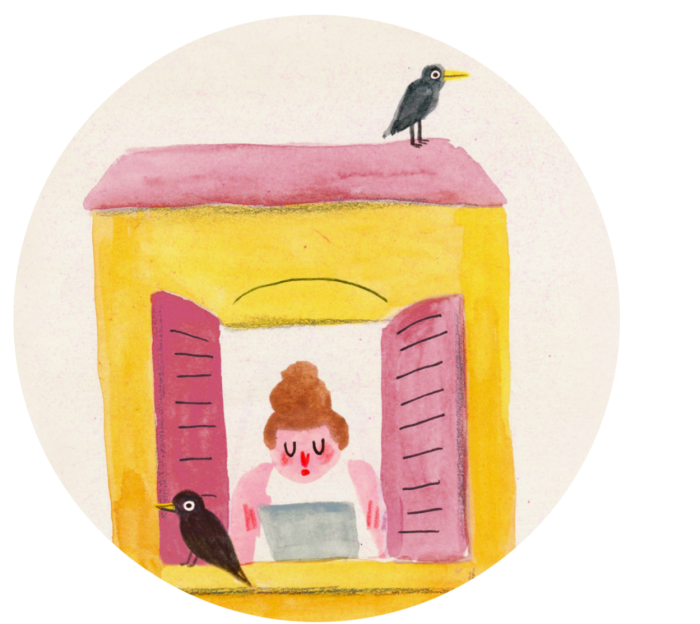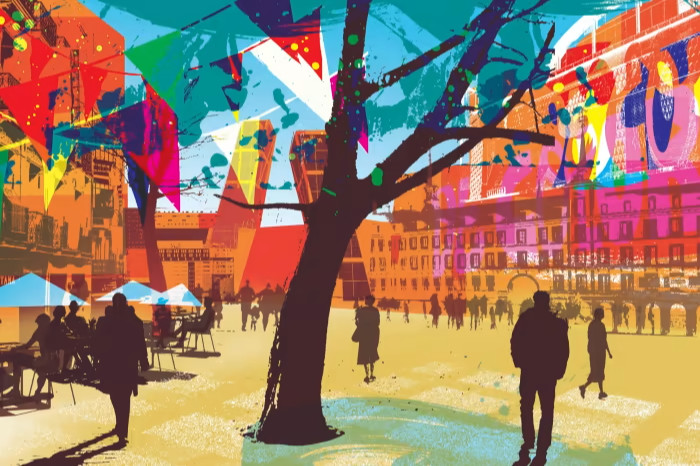How to be a digital nomad in Madrid

Roula Khalaf, Editor of the FT, selects her favourite stories in this weekly newsletter.
This article is part of a guide to Madrid from FT Globetrotter
An emerging tech hub, Madrid offers many of the benefits of a major global capital at a fraction of the cost, making it an attractive destination for remote workers. But until recently, it was hard for these digital nomads to remain in the city beyond the limits of the 90-day visa offered to non-EU nationals. All that has changed this year with Spain’s new Start-up Law — legislation aimed at attracting entrepreneurs and boosting the country’s tech scene. It gives freelancers and remote workers drawing a salary outside the EU the right to remain in the country for an initial period of one year, with the option to extend for up to five years. These workers pay taxes at a flat rate of 24 per cent on income up to €600,000 per year, and start-ups launching companies within Spain will pay 15 per cent — which works out to be less than the progressive rate paid by residents. Other European nations, including Portugal, Italy and Greece, have also introduced similar schemes in recent years to capitalise on the rise of remote work.

For those wanting to take advantage of this new digital nomad visa, Madrid, sitting slap-bang in the middle of the Iberian peninsula with high-speed rail links to major Spanish cities, makes an excellent choice. Throw in world-class museums, innovative restaurants and a spectacular nightlife and you have an almost unbeatable combination.
“[Madrid’s] got all the components digital nomads want, whether it’s the infrastructure or the safety. It’s also got good internet speeds and the right housing market,” says recent arrival Lynn Spreadbury, a location scout for Remote Year, a company that organises overseas trips for digital nomads.
The influx of new arrivals should gather speed as the capital ramps up its game as a tech hub, with Microsoft and Amazon making billion-euro investments in data centres, while the local government pours money into what is set to be Europe’s largest digital campus. Due to open in 2025, Campus Digital Valley will be spread over 7mn square metres. The enormous facility will focus on research and innovation in areas such as AI, robotics and cryptocurrency.
Despite all these advantages, dealing with the practicalities of a move to Spain’s capital can be overwhelming. Below is a brief guide to help you hit the ground running.
Where to live
At the time of writing, the minimum income for attaining a digital nomad visa is €2,520 per month (or double the minimum wage). While rental prices in the city have risen sharply in recent years, this should still be enough to afford decent accommodation in central Madrid, where a one-bed flat costs around €1,000 to €1,200 per month. Shared accommodation is a better option for those on a tight budget (more on this below).
A great option for those yet to come to grips with the Spanish language, the city centre offers the opportunity to quickly link up with a like-minded English-speaking community while also allowing one to gradually build links with Spanish speakers.
The vibrant neighbourhoods of Malasaña and neighbouring Chueca, the city’s gay district, are indisputably where the party is at, though those sensitive to noise will want to choose a flat overlooking an interior “patio” (a shaft-like space in the centre of Spanish apartment blocks that keeps the building cool in summer), rather than the noisy street.
Those looking for a more low-key central location should consider La Latina. One of the oldest parts of town, the area has charming medieval streets filled with tapas bars and restaurants. An even quieter life can be found just to the north in Chamberí, a genteel neighbourhood with a distinctly Parisian feel. This is also the most comfortable option in summer, when a breeze coming from the Sierra de Guadarrama mountains brings the temperature down to just about bearable levels. Lastly, for those looking to save money on rent, Puerta del Ángel is an up-and-coming area right by Casa de Campo park — it’s within walking distance of the centre and boasts the lively Tirso de Molina market, which is filled with great food stalls.
How to find accommodation

Flats get snapped up quickly in Madrid’s overheated market, so you have to be ready to make a fast decision. Most rental accommodation is listed on Idealista; however, once you factor in agency fees (up to one month’s rent) and deposits (up to two months’ rent), it can be expensive. Dan Tennant- Ralphs, a customer success manager at media-technology company ftrack, also sounds a note of caution. “Someone tried to scam me. They rented an Airbnb and listed it [on Idealista] as their own place. Be wary — do your homework and ask people to show you their ID.”
While Airbnb used to be a viable alternative to Idealista (many preferred it as it involves less paperwork), pent-up demand post-lockdown has significantly increased prices, so it’s best only used as a stop-gap while finding a more permanent alternative. Crowdsourcing is another way to secure a flat: on Facebook communities such as Digital Nomads Madrid, you can sometimes make informal arrangements directly with the owners and bypass expensive agency fees.
Alternatively, Urban Campus has four locations in the city offering mainly 25- to 40-year-old professionals accommodation for a single fee that includes utilities, cleaning and even your Netflix bill. It has both single-occupant and shared flats, the latter being a good option if you want to start life with a ready-made community of housemates.
Network and socialise
For those involved in start-ups, one of the best places in the city for networking is Google Campus. Reopened last year after a two-year closure brought on by the pandemic, this facility in the heart of Madrid is equipped with a restaurant, workspaces and meeting rooms.
Besides this, the Afterwork group on Meetup is a good place to get in touch with the city’s freelance community, both English- and Spanish-speaking. Keep an eye on Facebook groups too. Madrid Expats and Madrid Art and Culture often have in-person events listed where you can get to know both newbies and old-hands.
While Madrid has a less-established digital nomad community than the more popular destination of Barcelona, in some ways this is an advantage. Matthew Kirkham, CEO of social-impact AI start-up True Filter, recently made the switch from Barcelona to Madrid and says he is more comfortable in the capital. “People are quite friendly here. In Barcelona, I didn’t find that. Maybe because there are so many tourists there.”
With the new visa going live, the social situation for digital nomads looks set to change in the future. Sydney Addis, owner of digital marketing company The Inspiration Agency, says, “There’s not really a central hub yet, and that’s one of the things my agency will be trying to fix in 2023, by putting on in-person events.”
Co-working spaces

Madrid is awash with co-working spaces offering a range of different benefits from free beers to shower facilities, so it can be hard to choose. If you want to shop around before making a decision, download the Croissant app, which allows users to hop around from place to place, paying €19 a month for 10 hours. This will let you get a feel for the vibe of a space.
To find community quickly, look for a co-working space that offers opportunities for socialising. (Be aware that while you will be welcome in any co-working space, not all of them are geared towards non-Spanish speakers, so if you don’t speak much Spanish yet, make sure that at least the website is in English.) Area in Delicias, for instance, is ideal. Run by bilingual couple Hugo Tylor and Jack Wolton, it offers film screenings, breakfasts and spontaneous social events.
If you would rather immerse yourself in a Spanish-speaking community, Quinta del Sordo is one of the city’s most exciting co-working spaces. In a leafy corner of La Latina, it has a charming café and offers a number of social events along with regular art exhibitions.
Other practicalities

To break out of the English-speaking bubble as quickly as possible, sign up for intensive Spanish classes. My favourite school is Carpe Diem, a smaller, centrally located establishment that offers group and one-to-one classes at reasonable rates — they’ll have you feeling right at home as soon as you set foot through the door.
Those working from home will need to find a decent internet provider. Balancing speed and price considerations, at the time of writing, DIGI offers the best deals and attractive add-ons for mobile phone contracts.
Anyone with a digital nomad visa will also have to purchase health insurance. One of the most popular Spanish providers, Sanitas, does monthly plans from €26 to €50 per month depending on the individual and their needs.
The very first step, of course, is to apply for the visa itself. As there is plenty of bureaucracy to navigate, it is strongly advisable to hire a lawyer to do the grunt work for you, a service that should cost around €1,800. Applications should take around two months to process.
And once all that’s over, use your fledgling Spanish skills to order a well-deserved glass of vermouth in one of the city’s many beautiful squares, before setting off to explore the myriad facets of an ever-changing Madrid night.
Share your experiences of setting up a digital nomad in Madrid in the comments
Follow FT Globetrotter on Instagram at @FTGlobetrotter

Comments